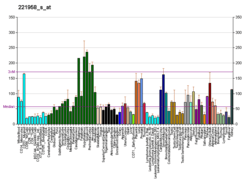GPR177
G protein-coupled receptor 177 (GPR177), commonly known as Wntless, is a human gene[5] that encodes a receptor for Wnt proteins in Wnt-secreting cells.[6]
Wntless was shown to be a cargo for the retromer complex.[6] It has been found essential for hair follicle induction.[7]
References
- GRCh38: Ensembl release 89: ENSG00000116729 - Ensembl, May 2017
- GRCm38: Ensembl release 89: ENSMUSG00000028173 - Ensembl, May 2017
- "Human PubMed Reference:". National Center for Biotechnology Information, U.S. National Library of Medicine.
- "Mouse PubMed Reference:". National Center for Biotechnology Information, U.S. National Library of Medicine.
- "Entrez Gene: GPR177 G protein-coupled receptor 177".
- Eaton S (January 2008). "Retromer retrieves wntless". Developmental Cell. 14 (1): 4–6. doi:10.1016/j.devcel.2007.12.014. PMID 18194646.
- Fu J, Hsu W (April 2013). "Epidermal Wnt controls hair follicle induction by orchestrating dynamic signaling crosstalk between the epidermis and dermis". The Journal of Investigative Dermatology. 133 (4): 890–8. doi:10.1038/jid.2012.407. PMC 3594635. PMID 23190887.
Further reading
- Bänziger C, Soldini D, Schütt C, Zipperlen P, Hausmann G, Basler K (May 2006). "Wntless, a conserved membrane protein dedicated to the secretion of Wnt proteins from signaling cells". Cell. 125 (3): 509–22. doi:10.1016/j.cell.2006.02.049. PMID 16678095.
- Otsuki T, Ota T, Nishikawa T, Hayashi K, Suzuki Y, Yamamoto J, Wakamatsu A, Kimura K, Sakamoto K, Hatano N, Kawai Y, Ishii S, Saito K, Kojima S, Sugiyama T, Ono T, Okano K, Yoshikawa Y, Aotsuka S, Sasaki N, Hattori A, Okumura K, Nagai K, Sugano S, Isogai T (2007). "Signal sequence and keyword trap in silico for selection of full-length human cDNAs encoding secretion or membrane proteins from oligo-capped cDNA libraries". DNA Research. 12 (2): 117–26. doi:10.1093/dnares/12.2.117. PMID 16303743.
- Clark HF, Gurney AL, Abaya E, Baker K, Baldwin D, Brush J, Chen J, Chow B, Chui C, Crowley C, Currell B, Deuel B, Dowd P, Eaton D, Foster J, Grimaldi C, Gu Q, Hass PE, Heldens S, Huang A, Kim HS, Klimowski L, Jin Y, Johnson S, Lee J, Lewis L, Liao D, Mark M, Robbie E, Sanchez C, Schoenfeld J, Seshagiri S, Simmons L, Singh J, Smith V, Stinson J, Vagts A, Vandlen R, Watanabe C, Wieand D, Woods K, Xie MH, Yansura D, Yi S, Yu G, Yuan J, Zhang M, Zhang Z, Goddard A, Wood WI, Godowski P, Gray A (October 2003). "The secreted protein discovery initiative (SPDI), a large-scale effort to identify novel human secreted and transmembrane proteins: a bioinformatics assessment". Genome Research. 13 (10): 2265–70. doi:10.1101/gr.1293003. PMC 403697. PMID 12975309.
- Matsuda A, Suzuki Y, Honda G, Muramatsu S, Matsuzaki O, Nagano Y, Doi T, Shimotohno K, Harada T, Nishida E, Hayashi H, Sugano S (May 2003). "Large-scale identification and characterization of human genes that activate NF-kappaB and MAPK signaling pathways". Oncogene. 22 (21): 3307–18. doi:10.1038/sj.onc.1206406. PMID 12761501.
See also
- GPR177+receptor,+human at the US National Library of Medicine Medical Subject Headings (MeSH)
This article incorporates text from the United States National Library of Medicine, which is in the public domain.
This article is issued from Wikipedia. The text is licensed under Creative Commons - Attribution - Sharealike. Additional terms may apply for the media files.




